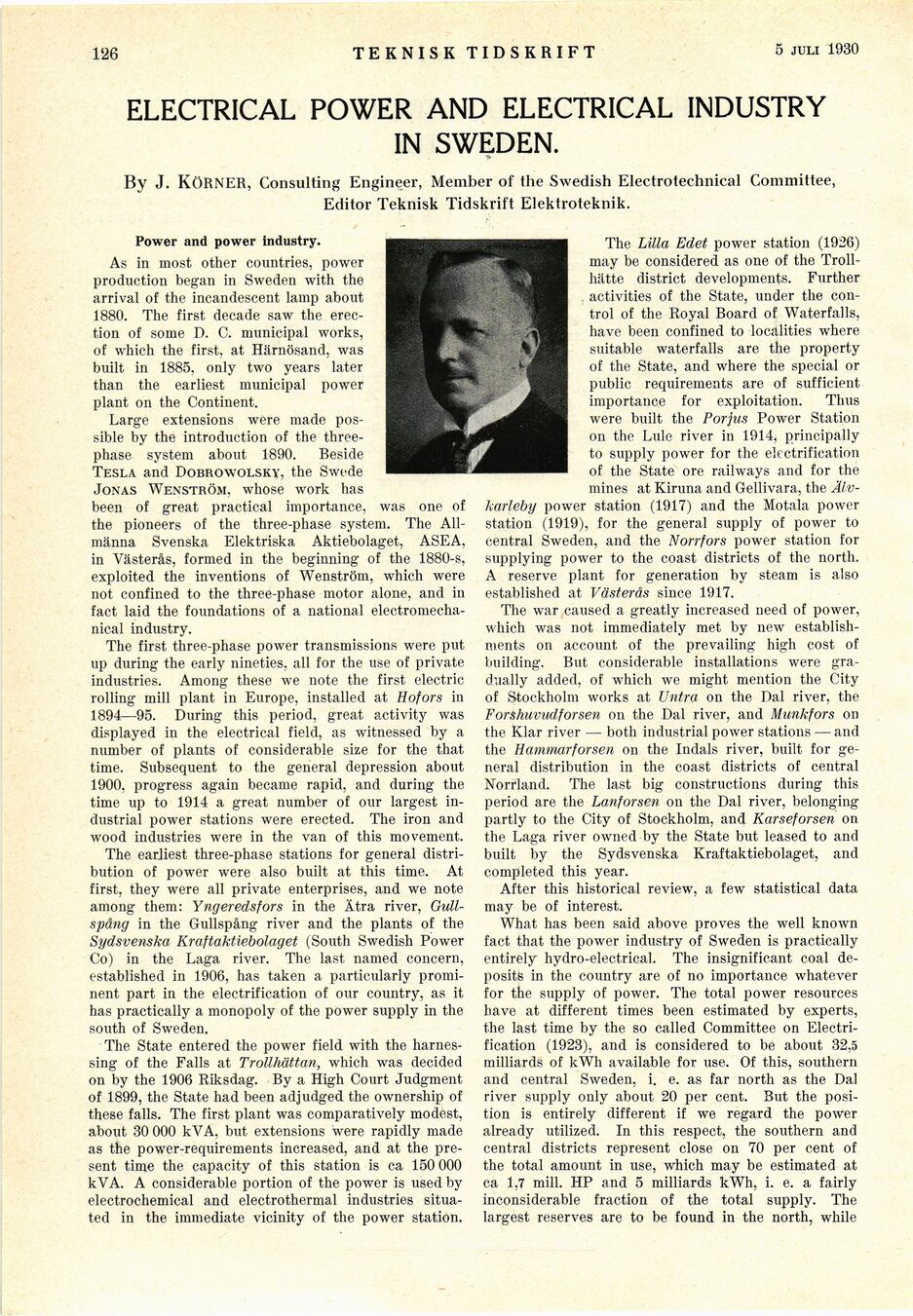
Full resolution (JPEG) - On this page / på denna sida - Sidor ...

<< prev. page << föreg. sida << >> nästa sida >> next page >>
Below is the raw OCR text
from the above scanned image.
Do you see an error? Proofread the page now!
Här nedan syns maskintolkade texten från faksimilbilden ovan.
Ser du något fel? Korrekturläs sidan nu!
This page has never been proofread. / Denna sida har aldrig korrekturlästs.
-126 teknisk tidskrift 1 febr. 1930
ELECTRICAL POWER AND ELECTRICAL INDUSTRY
IN SWEDEN.
By J. Körner, Consulting Engineer, Member of the Swedish Electrotechnical Committee,
Editor Teknisk Tidskrift Elektroteknik.
Power and power industry.
As in most other countries, power
production began in Sweden with the
arrival of the incandescent lamp about
1880. The first decade saw the
erection of some D. C. municipal works,
of which the first, at Härnösand, was
built in 1885, only two years later
than the earliest municipal power
plant on the Continent.
Large extensions were made
possible by the introduction of the
three-phase system about 1890. Beside
Tesla and Dobrowolsky, the Swede
Jonas Wenström, whose work has
been of great practical importance, was one of
the pioneers of the three-phase system. The
Allmänna Svenska Elektriska Aktiebolaget, ASEA,
in Västerås, formed in the beginning of the 1880-s,
exploited the inventions of Wenström, which were
not confined to the three-phase motor alone, and in
fact laid the foundations of a national
electromechanical industry.
The first three-phase power transmissions were put
up during the early nineties, all for the use of private
industries. Among these we note the first electric
rolling mill plant in Europe, installed at Hofors in
1894—95. During this period, great activity was
displayed in the electrical field, as witnessed by a
number of plants of considerable size for the that
time. Subsequent to the general depression about
1900, progress again became rapid, and during the
time up to 1914 a great number of our largest
industrial power stations were erected. The iron and
wood industries were in the van of this movement.
The earliest three-phase stations for general
distribution of power were also built at this time. At
first, they were all private enterprises, and we note
among them: Yngeredsfors in the Ätra river,
Gull-spâng in the Gullspång river and the plants of the
Sydsvenska Kraftaktiebolaget (South Swedish Power
Co) in the Laga river. The last named concern,
established in 1906, has taken a particularly
prominent part in the electrification of our country, as it
has practically a monopoly of the power supply in the
south of Sweden.
The State entered the power field with the
harnessing of the Falls at Trollhättan, which was decided
on by the 1906 Riksdag. By a High Court Judgment
of 1899, the State had been adjudged the ownership of
these falls. The first plant was comparatively modest,
about 30 000 kVA, but extensions were rapidly made
as the power-requirements increased, and at the
present time the capacity of this station is ca 150 000
kVA. A considerable portion of the power is used by
electrochemical and electrothermal industries
situated in the immediate vicinity of the power station.
The Lilla Edet power station (1926)
may be considered as one of the
Trollhätte district developments. Further
activities of the State, under the
control of the Royal Board of Waterfalls,
have been confined to localities where
suitable waterfalls are the property
of the State, and where the special or
public requirements are of sufficient
importance for exploitation. Thus
were built the Porjus Power Station
on the Lule river in 1914, principally
to supply power for the electrification
of the State ore railways and for the
mines at Kiruna and Gellivara, the
Älvkarleby power station (1917) and the Motala power
station (1919), for the general supply of power to
central Sweden, and the Norrfors power station for
supplying power to the coast districts of the north.
A reserve plant for generation by steam is also
established at Västerås since 1917.
The war caused a greatly increased need of power,
which was not immediately met by new
establishments on account of the prevailing high cost of
building. But considerable installations were
gradually added, of which we might mention the City
of Stockholm works at Untra on the Dal river, the
Forshuvudforsen on the Dal river, and Munkfors on
the Klar river — both industrial power stations — and
the Hammarforsen on the Indals river, built for
general distribution in the coast districts of central
Norrland. The last big constructions during this
period are the Lanforsen on the Dal river, belonging
partly to the City of Stockholm, and Karseforsen on
the Laga river owned by the State but leased to and
built by the Sydsvenska Kraftaktiebolaget, and
completed this year.
After this historical review, a few statistical data
may be of interest.
What has been said above proves the well known
fact that the power industry of Sweden is practically
entirely" hydro-electrical. The insignificant coal
deposits in the country are of no importance whatever
for the supply of power. The total power resources
have at different times been estimated by experts,
the last time by the so called Committee on
Electrification (1923), and is considered to be about 32,5
milliards of kWh available for use. Of this, southern
and central Sweden, i. e. as far north as the Dal
river supply only about 20 per cent. But the
position is entirely different if we regard the power
already utilized. In this respect, the southern and
central districts represent close on 70 per cent of
the total amount in use, which may be estimated at
ca 1,7 mill. HP and 5 milliards kWh, i. e. a fairly
inconsiderable fraction of the total supply. The
largest reserves are to be found in the north, while
<< prev. page << föreg. sida << >> nästa sida >> next page >>